Related Research Articles
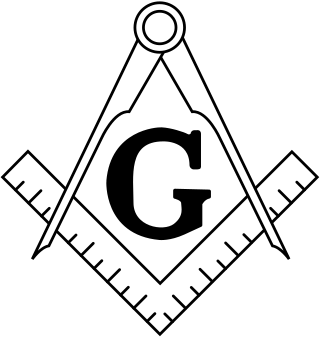
Freemasonry or Masonry refers to fraternal organisations that trace their origins to the local guilds of stonemasons that, from the end of the 14th century, regulated the qualifications of stonemasons and their interaction with authorities and clients. Modern Freemasonry broadly consists of two main recognition groups: Regular Freemasonry, which insists that a volume of scripture be open in a working lodge, that every member professes belief in a Supreme Being, that no women be admitted, and that the discussion of religion and politics do not take place within the lodge; and Continental Freemasonry, which consists of the jurisdictions that have removed some, or all, of these restrictions.

Gardnerian Wicca, or Gardnerian witchcraft, is a tradition in the neopagan religion of Wicca, whose members can trace initiatory descent from Gerald Gardner. The tradition is itself named after Gardner (1884–1964), a British civil servant and amateur scholar of magic. The term "Gardnerian" was probably coined by the founder of Cochranian Witchcraft, Robert Cochrane in the 1950s or 60s, who himself left that tradition to found his own.

Wicca, also known as "The Craft", is a modern pagan, syncretic, earth-centered religion. Considered a new religious movement by scholars of religion, the path evolved from Western esotericism, developed in England during the first half of the 20th century, and was introduced to the public in 1954 by Gerald Gardner, a retired British civil servant. Wicca draws upon ancient pagan and 20th-century hermetic motifs for theological and ritual purposes. Doreen Valiente joined Gardner in the 1950s, further building Wicca's liturgical tradition of beliefs, principles, and practices, disseminated through published books as well as secret written and oral teachings passed along to initiates.
Witchcraft, as most commonly understood in both historical and present-day communities, is the use of alleged supernatural powers of magic. A witch is a practitioner of witchcraft. Traditionally, "witchcraft" means the use of magic or supernatural powers to inflict harm or misfortune on others, and this remains the most common and widespread meaning. According to Encyclopedia Britannica, "Witchcraft thus defined exists more in the imagination of contemporaries than in any objective reality. Yet this stereotype has a long history and has constituted for many cultures a viable explanation of evil in the world". The belief in witchcraft has been found in a great number of societies worldwide. Anthropologists have applied the English term "witchcraft" to similar beliefs in occult practices in many different cultures, and societies that have adopted the English language have often internalised the term.

The Four Horsemen of the Apocalypse are figures in the Book of Revelation in the New Testament of the Bible, a piece of apocalypse literature attributed to John of Patmos. Similar allusions are contained in the Old Testament books of Ezekiel and Zechariah, written about six centuries prior. Though the text only provides a name for the fourth horseman, subsequent commentary often identifies them as personifications of Conquest (Zelos), War (Ares), Famine (Limos), and Death.
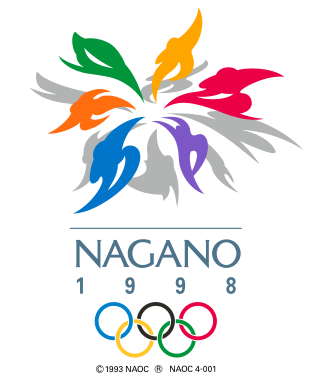
The 1998 Winter Olympics, officially known as the XVIII Olympic Winter Games and commonly known as Nagano 1998, were a winter multi-sport event held from 7 to 22 February 1998, mainly in Nagano, Nagano Prefecture, Japan, with some events taking place in the nearby mountain communities of Hakuba, Karuizawa, Nozawa Onsen, and Yamanouchi. The city of Nagano had previously been a candidate to host the 1940 Winter Olympics, as well as the 1972 Winter Olympics, but had been eliminated at the national level by Sapporo on both occasions.
The history of Freemasonry encompasses the origins, evolution and defining events of the fraternal organisation known as Freemasonry. It covers three phases. Firstly, the emergence of organised lodges of operative masons during the Middle Ages, then the admission of lay members as "accepted" or "speculative" masons, and finally the evolution of purely speculative lodges, and the emergence of Grand Lodges to govern them. The watershed in this process is generally taken to be the formation of the first Grand Lodge in London in 1717. The two difficulties facing historians are the paucity of written material, even down to the 19th century, and the misinformation generated by masons and non-masons alike from the earliest years.
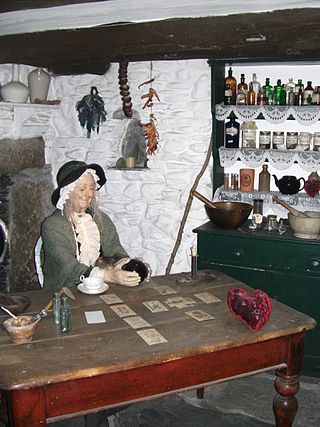
The cunning folk were professional or semi-professional practitioners of magic in Europe from the medieval period through the early 20th century. In Britain they were known by a variety of names in different regions of the country, including wise men and wise women, pellars, wizards, dyn hysbys, and sometimes white witches.

Filiki Eteria or Society of Friends was a secret political and revolutionary organization founded in 1814 in Odessa, whose purpose was to overthrow the Ottoman rule of Greece and establish an independent Greek State. Society members were mainly young Phanariot Greeks from Constantinople and the Russian Empire, local political and military leaders from the Greek mainland and islands, as well as several Orthodox Christian leaders from other nations that were under Hellenic influence, such as Karađorđe from Serbia, and Tudor Vladimirescu from Romania. One of its leaders was the prominent Phanariote Prince Alexander Ypsilantis. The Society initiated the Greek War of Independence in the spring of 1821.

The New Forest coven were an alleged group of pagan witches who met around the area of the New Forest in southern England during the early 20th century. According to his own claims, in September 1939, a British occultist named Gerald Gardner was initiated into the coven and subsequently used its beliefs and practices as a basis from which he formed the tradition of Gardnerian Wicca. Gardner described some of his experiences with the coven in his published books Witchcraft Today (1954) and The Meaning of Witchcraft (1959) although on the whole revealed little about it, saying he was respecting the privacy of its members. Meanwhile, another occultist, Louis Wilkinson, corroborated Gardner's claims by revealing in an interview with the writer Francis X. King that he too had encountered the coven and expanded on some of the information that Gardner had provided about them. According to Gardner, the faith they followed was the Witch-Cult, a supposed pagan religion that had survived in secret after the Christianization of Europe. This was in keeping with the now-discredited theories of Margaret Murray and her supporters.
Jimmy MacBeath (1894–1972) was a Scottish Traveller and Traditional singer of the Bothy Ballads from the north east of Scotland. He was both a mentor and source for fellow singers during the mid 20th century British folk revival. He had a huge repertoire of songs, which were recorded by Alan Lomax and Hamish Henderson.
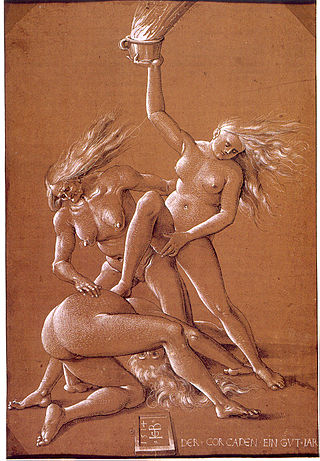
European witchcraft is a multifaceted historical and cultural phenomenon that unfolded over centuries, leaving a mark on the continent's social, religious, and legal landscapes. The roots of European witchcraft trace back to classical antiquity when concepts of magic and religion were closely related, and society closely integrated magic and supernatural beliefs. Ancient Rome, then a pagan society, had laws against harmful magic. In the Middle Ages, accusations of heresy and devil worship grew more prevalent. By the early modern period, major witch hunts began to take place, partly fueled by religious tensions, societal anxieties, and economic upheaval. Witches were often viewed as dangerous sorceresses or sorcerers in a pact with the Devil, capable of causing harm through black magic. A feminist interpretation of the witch trials is that misogynist views of women led to the association of women and malevolent witchcraft.
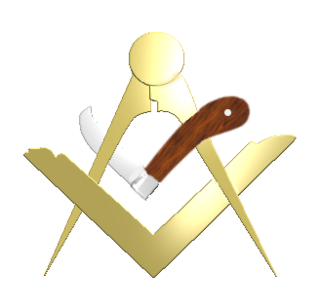
The Order of Free Gardeners is a fraternal society that was founded in Scotland in the middle of the 17th century and later spread to England and Ireland. Like numerous other friendly societies of the time, its principal aim was the sharing of secret knowledge linked to the profession and mutual aid. In the 19th century, its activities of mutual insurance became predominant. By the end of the 20th century, it had become almost entirely extinct, but that can be revised due to some growth in the early 21st century.
The history of Wicca documents the rise of the Neopagan religion of Wicca and related witchcraft-based Neopagan religions. Wicca originated in the early 20th century, when it developed amongst secretive covens in England who were basing their religious beliefs and practices upon what they read of the historical witch-cult in the works of such writers as Margaret Murray. It was subsequently founded in the 1950s by Gardner, who claimed to have been initiated into the Craft – as Wicca is often known – by the New Forest coven in 1939. Gardner's form of Wicca, the Gardnerian tradition, was spread by both him and his followers like the High Priestesses Doreen Valiente, Patricia Crowther and Eleanor Bone into other parts of the British Isles, and also into other, predominantly English-speaking, countries across the world. In the 1960s, new figures arose in Britain who popularized their own forms of the religion, including Robert Cochrane, Sybil Leek and Alex Sanders, and organizations began to be formed to propagate it, such as the Witchcraft Research Association. It was during this decade that the faith was transported to the United States, where it was further adapted into new traditions such as Feri, 1734 and Dianic Wicca in the ensuing decades, and where organizations such as the Covenant of the Goddess were formed.

The Museum of Witchcraft and Magic, formerly known as the Museum of Witchcraft, is a museum dedicated to European witchcraft and magic located in the village of Boscastle in Cornwall, south-west England. It houses exhibits devoted to folk magic, ceremonial magic, Freemasonry, and Wicca, with its collection of such objects having been described as the largest in the world.
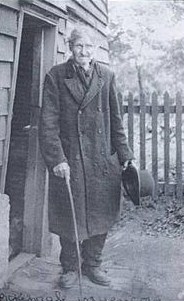
George Pickingill was an English farm labourer who lived and worked in the village of Canewdon in the eastern English county of Essex. Widely considered to be a cunning man, or vocational folk magician, he reportedly employed magical means to offer cures for ailments and to locate lost property, although was also alleged to have threatened to place curses on people.
Coined in the 18th century in imitation of the Mason's Word, which restricted access to the lodges of Stonemasons and later Freemasonry, and followed by the Horseman's Word, the Miller's Word identified members of a trade guild formed to restrict entry into and control the profession of grain milling, as well as to protect its members' interests. Like the Masons Word, its foundation was local groups with initiations, passwords, and secret trade knowledge.
In the early modern period, from about 1400 to 1775, about 100,000 people were prosecuted for witchcraft in Europe and British America. Between 40,000 and 60,000 were executed. The witch-hunts were particularly severe in parts of the Holy Roman Empire. Prosecutions for witchcraft reached a high point from 1560 to 1630, during the Counter-Reformation and the European wars of religion. Among the lower classes, accusations of witchcraft were usually made by neighbors, and women made formal accusations as much as men did. Magical healers or 'cunning folk' were sometimes prosecuted for witchcraft, but seem to have made up a minority of the accused. Roughly 80% of those convicted were women, most of them over the age of 40. In some regions, convicted witches were burnt at the stake.

The witch-cult hypothesis is a discredited theory that the witch trials of the Early Modern period were an attempt to suppress a pagan religion that had survived the Christianization of Europe. According to its proponents, accused witches were actually followers of this alleged religion. They argue that the supposed 'witch cult' revolved around worshiping a Horned God of fertility and the underworld, whom Christian persecutors identified with the Devil, and whose followers held nocturnal rites at the witches' Sabbath.

The Headless Horseman is an archetype of mythical figure that has appeared in folklore around Europe since the Middle Ages. The figures are traditionally depicted as riders upon horseback who are missing their heads. These myths have since inspired a number of stories and characters in popular culture, including The Legend of Sleepy Hollow.
References
- 1 2 3 4 Hutton 1999b, p. 8.
- ↑ Hutton 1999a, p. 62; Hutton 1999b, p. 6.
- 1 2 Hutton 1999b, p. 6.
- ↑ Hutton 1999a, pp. 59–60; Hutton 1999b, p. 6.
- 1 2 3 4 Hutton 1999a, p. 62; Hutton 1999b, p. 7.
- 1 2 Hutton 1999a; Hutton 1999b, p. 7.
- 1 2 3 Neat 2002, p. 62.
- ↑ Fernee 2009, p. 3.
- 1 2 Neat 2002, p. xix.
- 1 2 3 4 Hutton 1999a, p. 62.
- ↑ Samuel 1981, p. 88.
- ↑ Fernee 2009, p. 15.
- 1 2 Neat 2002, p. 65.
- 1 2 Hutton 1999a, p. 63; Hutton 1999b, p. 7.
- ↑ Hutton 1999a, p. 63; Hutton 1999b, pp. 7–8.
- 1 2 3 4 Hutton 1999a, p. 63.
- 1 2 3 4 Hutton 1999a, p. 63; Hutton 1999b, p. 8.
- 1 2 Neat 2002, p. 67.
- ↑ Neat 2002, pp. 64–65.
- ↑ Baron of Kilmarnock 2009.
- 1 2 3 4 Neat 2002, p. 53.
- ↑ Hutton 1999b, p. 7; Neat 2002, p. 66.
- 1 2 3 4 Hutton 1999b, p. 7.
- ↑ Neat 2002, p. 59.
- ↑ Neat 2002, pp. 53–54.
- ↑ Neat 2002, pp. 53–58.
- 1 2 Neat 2002, p. 58.
- 1 2 Porter 1998.
- ↑ Hutton 1999. p. 62.
- ↑ Ankarloo and Clark, Witchcraft and Magic in Europe, 8.
- ↑ Kerr 2004, p. 11.
- 1 2 Society Meetings. (Folklore, Vol. 82, No. 1. Spring, 1971), 88.
- ↑ Fernee 2009, p. 4.
- ↑ Quoted in Fernee 2009 , p. 30.
- ↑ McPherson 1929, pp. 290–292; Hutton 1999a, p. 61.
- ↑ Davidson 1956, p. 70-72; Hutton 1999a, p. 61.
- ↑ Evans 1966, p. 228-235.
- ↑ Evans 1972, p. 225.
- ↑ Evans 1975, p. 42-43.
- ↑ Evans 1979, p. 137-141.
- ↑ Hutton 1999a, p. 61.
- ↑ Henderson 1962, p. 696-698.
- ↑ Carter 1979, p. 154-156.
- ↑ Fernee 2009, p. 1.
Works cited
- Baron of Kilmarnock (2009). "The Horseman's Word". The Lordship and Baronate of Kilmarnock. Archived from the original on 2 April 2015. Retrieved 8 February 2016.
- Carter, Ian (1979). Farm Life in Northeast Scotland 1840-1914. Edinburgh: John Donald.
- Davidson, Thomas (1956). "The Horseman's Word". Gwerin 2.
- Evans, George Ewart (1966). The Pattern under the Plough. London: Faber. ISBN 978-0-571-24379-2.
- Evans, George Ewart (1972). The Leaping Hare. London: Faber. ISBN 978-0-571-10630-1.
- Evans, George Ewart (1975). The Days That We Have Seen . London: Faber. ISBN 978-0-571-24380-8.
- Evans, George Ewart (1979). Horse Power and Magic. London: Faber. ISBN 978-0-571-24664-9.
- Fernee, Ben (2009). The Society of the Horseman's Word. Hinckley, Leicestershire: The Society of Esoteric Endeavour. ISBN 978-0-9563713-0-0.
- Henderson, Hamish (June 1962). "A Slight Case of Devil Worship". New Statesman and Nation.
- Hutton, Ronald (1999a). The Triumph of the Moon: A History of Modern Pagan Witchcraft. Oxford: Oxford University Press. ISBN 978-0192854490.
- Hutton, Ronald (1999b). "Modern Pagan Witchcraft". In Bengt Ankarloo; Stuart Clark (eds.). The Athlone History of Witchcraft and Magic, Volume 6: The Twentieth Century. London: Athlone Press. pp. 1–79. ISBN 978-0485890068.
- Kerr, Peter (2004). Thistle Soup: A Ladleful of Scottish Life. Globe Pequot.
- Lyon, Russell (2003). The Quest for the Original Horse Whisperers. Edinburgh: Luath Press. ISBN 978-1842820209.
- McPherson, J.M. (1929). Primitive Beliefs in the North-East of Scotland. London: Longman.
- Neat, Timothy (2002). The Horseman's Word: Blacksmiths and Horsemanship in Twentieth-Century Scotland. Edinburgh: Birlinn. ISBN 978-1841580944.
- Porter, James (1998). "The Folklore of Northern Scotland: Five Discourses on Cultural Representation". Folklore. 109 (1–2): 1–14. doi:10.1080/0015587X.1998.9715956.
- Samuel, Raphael (1981). People's History and Socialist Theory. London: Routledge.